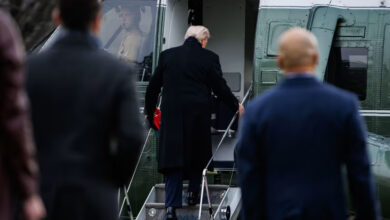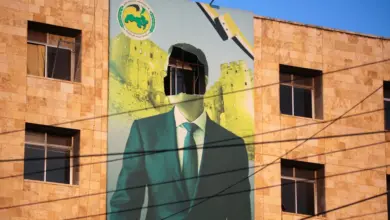
HOMS, Syria (AP) — Six months after he was snatched from a road in central Syria, Iyad Suleiman was allowed by his kidnappers to make a Skype video call home. His children were startled at how he looked — skinny and exhausted, with a long beard. He told his wife to keep talking with his captors and Syrian officials to win his freedom.
That two-minute call in September 2013 was the last Suleiman’s family saw of him. Soon after, his captors ended contact. Ever since, his wife and children have lived in an agonizing limbo, not knowing if he is alive or dead.
“I think of him all day. I wake up and cry in the middle of the night. I don’t know what happens to me,” Suleiman’s 11-year-old son, Yacoub, said, bursting into tears.
Suleiman, a member of Syria’s parliament at the time, was kidnapped by militants from the al-Qaida-linked Nusra Front and vanished into the opposition-held territories in northwest Syria.
In Syria’s 8-year-old civil war, more than 100,000 people have been detained, abducted or gone missing, according to the U.N. The large majority of those were “forcibly disappeared” by the government, which has targeted opponents for arrest throughout the war, starting with its crackdown on protests that erupted in 2011. Many are believed to have gone into government prisons where rights groups say torture is pervasive.
A smaller number from the government side, like Suleiman, were taken captive by opposition forces in a war that became brutally sectarian over time.
And tens of thousands more have likely vanished into mass graves, most of them victims of the Islamic State group during its 2014-2018 rule over northern and eastern Syria. Those victims come from all sides in the conflict, including government soldiers, opposition fighters, Kurdish militiamen and civilians.
“All Syrians, no matter their affiliations, are touched by this issue,” said U.N. special envoy for Syria Geir Pedersen.
In her home city of Homs, Suleiman’s wife, Suzan, choked back tears as she recounted her husband’s abduction. On March 11, 2013, he was returning home from the town of Palmyra, where he had gone to try and broker a local reconciliation; he passed the nearby village of Furqlus and disappeared. Suleiman and his family belong to Syria’s Alawite minority, a bedrock of support for President Bashar Assad, also an Alawite.
Suzan, a schoolteacher, was pregnant at the time.
Three days later, Suleiman’s kidnappers, from the Nusra Front, called his family. They put him on the phone and demanded ransom. Suleiman’s brothers and brothers-in-law went to hand over payment at a site near Palmyra. But when the militants wouldn’t let them talk to Suleiman first, they turned around, fearing it was a trap to kidnap them as well.
Over the next months, the kidnappers sent names of militants held by the government, demanding a swap. Each time, the government refused. Once, the authorities did seem ready for a trade, even telling Suzan that her husband would be back with her within days. But in the end nothing happened, and the officials gave no explanation.
American freelance photojournalist Matthew Schrier, who was snatched by al-Qaida militants on the last day of 2012, crossed paths with Suleiman during this time.
Schrier told The Associated Press that they were together more than two months and became friends, held first in the basement of a villa, then in a children’s hospital in Aleppo used as a prison. They spent long hours playing chess, using a cloth as a board and crumpled-up aluminum foil for pieces, or talking about everything from politics and religion to their families.
Schrier said they were not physically abused, though he has said he was tortured later in his imprisonment. But conditions were difficult, at times cramped with two dozen other prisoners, mostly government soldiers or allied militiamen. Their complex was hit several times by government forces, and fighting between Nusra Front and rivals erupted right outside, he said.
Eventually, Schrier was moved to another prison. In July 2013, he managed to escape, squeezing out a window.
Schrier maintains contact with Suleiman’s family. He said he doesn’t like to speculate about his fate. “When I was gone everybody thought I was dead. Look what happened. I popped up and I was alive.”
“I tell myself that he’s still around somewhere,” he said.
Answers come only slowly, if at all, to families of the missing, even as Syria’s war shifts and changes, with the Islamic State group losing all its lands and the government clawing back most — but not all — territory once held by opposition factions.
Some of those whose relatives were taken by the government have received partial answers. Authorities last year began issuing death certificates for thousands of detainees. Some had died as long as six years ago. Still, authorities have returned no bodies, leaving some with lingering doubts over their loved ones’ fates.
At the same time, authorities are trying to build a mechanism to deal with the unknown dead who arise from Syria’s many killing zones. Syrian officials have been compiling a database of unidentified dead found in areas under state control, which families can search through for missing loved ones.
When an unidentified body is found, forensic experts photograph the face and body or take DNA samples, said Zaher Hajo, of Syria’s General Commission of Forensic Medicine. The information is kept with the number of the grave where the body is buried.
Over the past years, authorities have been able to help identify 1,670 bodies, Hajo said, though he would not say how large the database was.
The majority come from mass graves in territory liberated from the Islamic State group. In eastern Syria, once the heartland of IS rule, Kurdish-led authorities have similarly been compiling their own databases as they extract bodies from mass graves in the city of Raqqa.
In the meantime, families desperately seek any scrap of information.
After the final Skype call, Suleiman’s family heard from released prisoners that he was given to another Islamic militant faction, Ahrar al-Sham. Years have passed with no further news, even as government forces retook all of Aleppo and now wage a campaign against the rebels’ last stronghold, centered on Idlib province.
Prisoner exchanges between the government and insurgents continue to take place. In the most recent, just over a dozen from each side were freed in Aleppo in late July. Suzan contacts anyone released to see if they saw or heard of her husband.
The kidnappers “never said that they eliminated him, so we are living on hope,” she said. Every year on Oct. 1, the family celebrates Suleiman’s birthday.
The family stopped receiving Suleiman’s salary when his four-year term in parliament ended in 2016, since he is not counted as a “martyr,” whose families go on receiving their salaries for life.
Suzan said she tries to give their children as normal a life as possible. The youngest, Youssef, born seven months after his father’s kidnapping, always asks when he is coming back, Suzan said.
Their eldest, 14-year-old Engi, described how, in that brief Skype call six years ago, she and her younger brother Yacoub told their father all about the new school year.
“Even among the harshest people there are emotions. If they have some emotions, they should send him back to us,” she said.
Yacoub burst into sobs. When his father returns, he said, “I will not leave him for a moment.”
___
Associated Press writers Josef Federman in Amman, Jordan, and Edith M. Lederer at the United Nations contributed to this report.
By BASSEM MROUE
Photo: In this July 26, 2019 photo, schoolteacher Suzan Suleiman hugs and kisses her son Youssef, 6, during an interview in Homs, Syria. Six months after he was snatched from a road in central Syria, Iyad Suleiman, a father of three, was allowed by his kidnappers to make a Skype video call home. His children were startled at how he looked skinny and exhausted, with a long beard. That two-minute call in September 2013 was the last Suleiman’s family saw of him. (AP Photo/Hassan Ammar)




